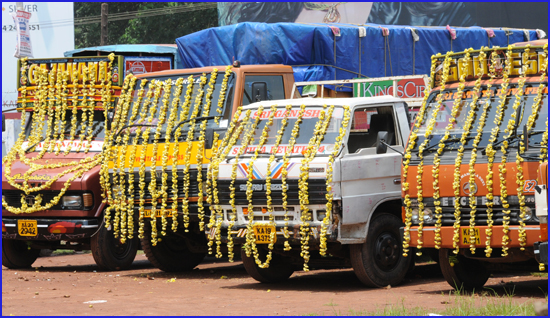Ayudha Puja falls during Maha Navratri and it is popular only in South India mainly in Karnataka, Tamil Nadu, Andhra Pradesh and Kerala. Ayudha Puja is done on Navami Tithi during Navratri. In southern India we also celebrate this day as Sarawati Puja. Ayudha Puja is also known as Shastra Puja and Astra Puja.
On the ninth day of the Dasara festival, weapons and tools are worshipped. In Karnataka, the celebration is for killing of the demon king Mahishasura by goddess Chamundeshwari. After slaying of the demon king, the weapons were kept out for worship. While Navaratri festival is observed all over the country but in South Indian states, where it is widely celebrated as Ayudha Puja, there are slight variations of worship procedure
Historically Ayudha Puja was meant to worship weapons but in its present form all sort of instruments are worshipped on the very same day. In South India it is a day when craftsmen worship their tools and instruments similar to Vishwakarma Puja in other parts of India.
Tradition in Ayudha Puja:
The tools and all implements of vocation are first cleaned. All the tools, machines, vehicles and other devices are then painted or well polished after which they are smeared with turmeric paste, sandalwood paste (in the form of a tilak (insignia or mark)) and Kumkum (vermillion). Then, in the evening, previous to the puja day, they are placed on an earmarked platform and decorated with flowers. In the case of weapons of war, they are also cleaned, bedecked with flowers and tilak and placed in a line, adjacent to a wall. On the morning of the puja that is on the navami day, they are all worshipped along with the images of Saraswati, Lakshmi and Parvati. Books and musical instruments are also placed on the pedestal for worship. Now a days we worship all the machinery, vehicles, computers, instruments in Ayudh Puja.
History behind Ayudha Puja:
It is said that on Vijayadashami day Arjuna, third of the five Pandava brothers, retrieved his weapons of war from the hole in the Shami tree where he had hidden it before proceeding on the forced exile. After completing his vanvas (exile period) of 13 years including one year of Agyatavas (living incognito) before embarking on the war path against the Kauravas he retrieved his weapons. In the Kurukshetra war that ensued, Arjuna was victorious. Pandavas returned on Vijayadashami day and since then it is believed that this day is auspicious to begin any new venture. But in Karnataka Ayudh Puja is celebrated by general public one day before of original festival day Vijayadashami(the Ayudh Puja Day).
Another legend is of a pre-battle ritual involving human sacrifice as part of the Ayudh Puja. The past practice is narrated in the Tamil version of Mahabharata epic. In this ritual, prevalent then in Tamil Nadu, ‘Kalapalli’ was a “sacrifice to the battlefield”, which involved human sacrifice before and after battles. Duryodhana, the Kaurava chief was advised by astrologer (Sahadeva) that the propitious time for performing Kalapalli was on amavasya day (New Moon day), one day before the start of Kurukshetra war and Iravan (son of Arjuna), also spelt Aravan, had agreed to be the victim for the sacrifice. But Krishna, the benefactor of Pandavas smelt trouble and he devised a plan to persuade Iravan to be the representative of the Pandavas and also of the Kauravas. Krishna had suggested to Yudhishthira-the eldest of the Pandavas, to sacrifice Aravan to goddess Kali as a part of Ayudh Puja. After this sacrifice, Kali had blessed Pandavas for victory in the Kurukshetra war.

Be the first to comment on "All you need to know about Ayudha Puja"